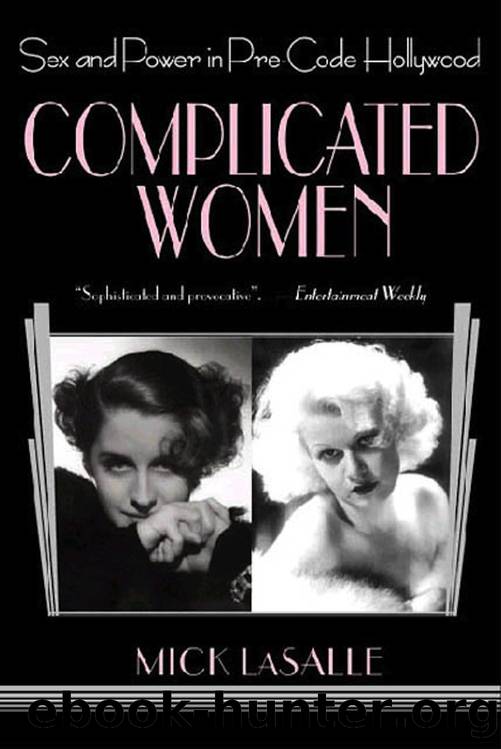Complicated Women: Sex and Power in Pre-Code Hollywood by Mick LaSalle

Author:Mick LaSalle [LaSalle, Mick]
Language: eng
Format: epub
ISBN: 9781466876972
Publisher: St. Martin's Press
Published: 2014-08-05T04:00:00+00:00
8
THE GHASTLY JOB OF LIVING TOGETHER
The pre-Codes weren’t just fun and games. If all the coming of the Code did was delay on-screen nudity—or postpone by a generation the day when every magazine interview with an actress had to be accompanied by photos of said actress in her underwear—the loss to culture would be negligible.
The loss was real and profound. In the early thirties, and especially as the pre-Code era wore on, Hollywood addressed women’s issues and problems with artistry and seriousness. Women’s stories were being told. They were being told well. In some cases, these stories were not to be told again for thirty years.
Take the case of Men in White (1934), which dealt with abortion. Elizabeth Allan played a sweet-tempered British nurse, working in America. One night, weary and restless from being surrounded by disease and death, she goes to bed with a doctor, played by Clark Gable. When next we meet her, she is a patient herself, suffering complications from a back-alley abortion. “Why didn’t she come to me?” Gable asks.
Though the word “abortion” was never stated, the film left no room for ambiguity. The nurse is rushed into surgery and tries to regain her strength over the course of the film. No one ever tells her she is a bad woman. No one passes any moral judgment on her at all. The picture, based on the stage play by Sidney Kingsley (future husband of Madge Evans), accepts people as people. From the movie’s point of view, the only tragedy here is that the woman felt she had to get an abortion from a butcher.
Men in White was a unique case. To my knowledge it was the only pre-Code whose plot centers around an abortion, though abortion had been alluded to in earlier films. Men in White met with protest at the time, but it got made, and who knows what similar women’s stories might have been told? Were it not for the Code, which arrived less than three months later, Men in White might not have been an end but a beginning.
After the Code, crime films, adventures, gangster films, war movies, and comedies all continued to get produced, with some adjustments. But the social dramas that took a woman’s point of view, that remained on the woman’s side from start to finish, requiring of her no last-minute conversion, apology, or reversion to happy subservience, all but disappeared. One can infer the intent of censorship by seeing what exactly got censored.
Until then, movies provided a rich variety of socially responsive women’s pictures. Abortion may have been taboo, but stories about marriage were fairly common. These marriage films weren’t just about married characters. They explored the institution of marriage itself. They questioned marriage, tested it, and explored it, as if to see what it meant, what still worked, and what needed to be overhauled in light of the modern woman’s emergence.
Some of the era’s best films about marriage were made by the remarkable Ann Harding, who with Garbo and Hopkins was among the most talented actresses of the era.
Download
This site does not store any files on its server. We only index and link to content provided by other sites. Please contact the content providers to delete copyright contents if any and email us, we'll remove relevant links or contents immediately.
The Kite Runner by Khaled Hosseini(5082)
Gerald's Game by Stephen King(4578)
Dialogue by Robert McKee(4321)
The Perils of Being Moderately Famous by Soha Ali Khan(4169)
The 101 Dalmatians by Dodie Smith(3451)
Story: Substance, Structure, Style and the Principles of Screenwriting by Robert McKee(3397)
The Pixar Touch by David A. Price(3362)
Confessions of a Video Vixen by Karrine Steffans(3242)
How Music Works by David Byrne(3184)
Fantastic Beasts: The Crimes of Grindelwald by J. K. Rowling(2994)
Harry Potter 4 - Harry Potter and The Goblet of Fire by J.K.Rowling(2987)
Slugfest by Reed Tucker(2938)
The Mental Game of Writing: How to Overcome Obstacles, Stay Creative and Productive, and Free Your Mind for Success by James Scott Bell(2844)
4 - Harry Potter and the Goblet of Fire by J.K. Rowling(2652)
Screenplay: The Foundations of Screenwriting by Syd Field(2572)
The Complete H. P. Lovecraft Reader by H.P. Lovecraft(2514)
Scandals of Classic Hollywood: Sex, Deviance, and Drama from the Golden Age of American Cinema by Anne Helen Petersen(2465)
Wildflower by Drew Barrymore(2442)
Robin by Dave Itzkoff(2383)
